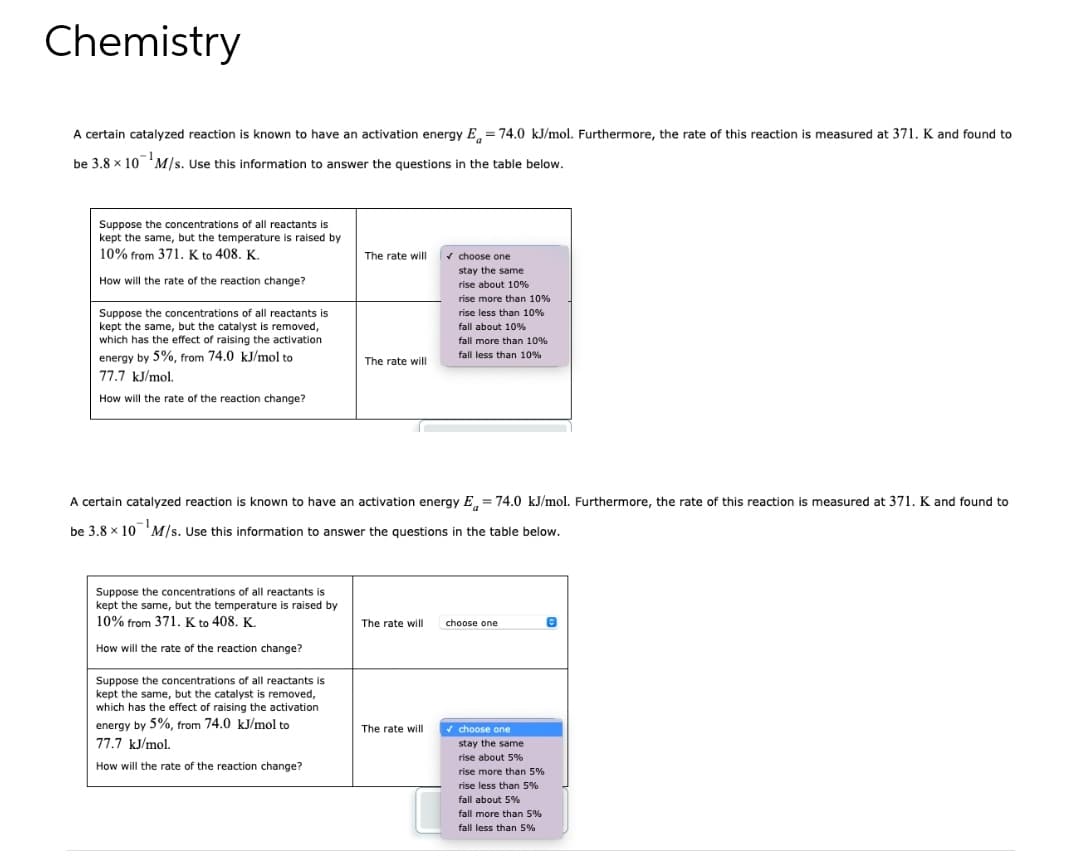A certain catalyzed reaction is known to have an activation energy E= 74.0 kJ/mol. Furthermore, the rate of this reaction is measured at 371. K and found to be 3.8 x 10 M/s. Use this information to answer the questions in the table below. Suppose the concentrations of all reactants is kept the same, but the temperature is raised by 10% from 371. K to 408. K. How will the rate of the reaction change? Suppose the concentrations of all reactants is kept the same, but the catalyst is removed, which has the effect of raising the activation energy by 5%, from 74.0 kJ/mol to 77.7 kJ/mol. How will the rate of the reaction change? The rate will The rate will choose one stay the same rise about 10% rise more than 10% rise less than 10% fall about 10% fall more than 10% fall less than 10%
A certain catalyzed reaction is known to have an activation energy E= 74.0 kJ/mol. Furthermore, the rate of this reaction is measured at 371. K and found to be 3.8 x 10 M/s. Use this information to answer the questions in the table below. Suppose the concentrations of all reactants is kept the same, but the temperature is raised by 10% from 371. K to 408. K. How will the rate of the reaction change? Suppose the concentrations of all reactants is kept the same, but the catalyst is removed, which has the effect of raising the activation energy by 5%, from 74.0 kJ/mol to 77.7 kJ/mol. How will the rate of the reaction change? The rate will The rate will choose one stay the same rise about 10% rise more than 10% rise less than 10% fall about 10% fall more than 10% fall less than 10%
Introductory Chemistry: A Foundation
9th Edition
ISBN:9781337399425
Author:Steven S. Zumdahl, Donald J. DeCoste
Publisher:Steven S. Zumdahl, Donald J. DeCoste
Chapter17: Equilibrium
Section: Chapter Questions
Problem 9CR
Related questions
Question

Transcribed Image Text:Chemistry
A certain catalyzed reaction is known to have an activation energy E = 74.0 kJ/mol. Furthermore, the rate of this reaction is measured at 371. K and found to
be 3.8 x 10 M/s. Use this information to answer the questions in the table below.
Suppose the concentrations of all reactants is
kept the same, but the temperature is raised by
10% from 371. K to 408. K.
How will the rate of the reaction change?
Suppose the concentrations of all reactants is
kept the same, but the catalyst is removed,
which has the effect of raising the activation
energy by 5%, from 74.0 kJ/mol to
77.7 kJ/mol.
How will the rate of the reaction change?
Suppose the concentrations of all reactants is
kept the same, but the temperature is raised by
10% from 371. K to 408. K.
How will the rate of the reaction change?
The rate will
Suppose the concentrations of all reactants is
kept the same, but the catalyst is removed,
which has the effect of raising the activation
energy by 5%, from 74.0 kJ/mol to
77.7 kJ/mol.
How will the rate of the reaction change?
The rate will
A certain catalyzed reaction is known to have an activation energy E= 74.0 kJ/mol. Furthermore, the rate of this reaction is measured at 371. K and found to
be 3.8 x 10 M/s. Use this information to answer the questions in the table below.
The rate will
✓ choose one
stay the same
rise about 10%
The rate will
rise more than 10%
rise less than 10%
fall about 10%
fall more than 10%
fall less than 10%
choose one
✓ choose one
stay the same
rise about 5%
rise more than 5%
rise less than 5%
fall about 5%
fall more than 5%
fall less than 5%
e
Expert Solution
This question has been solved!
Explore an expertly crafted, step-by-step solution for a thorough understanding of key concepts.
Step by step
Solved in 3 steps with 2 images

Knowledge Booster
Learn more about
Need a deep-dive on the concept behind this application? Look no further. Learn more about this topic, chemistry and related others by exploring similar questions and additional content below.Recommended textbooks for you

Introductory Chemistry: A Foundation
Chemistry
ISBN:
9781337399425
Author:
Steven S. Zumdahl, Donald J. DeCoste
Publisher:
Cengage Learning


Chemistry
Chemistry
ISBN:
9781305957404
Author:
Steven S. Zumdahl, Susan A. Zumdahl, Donald J. DeCoste
Publisher:
Cengage Learning

Introductory Chemistry: A Foundation
Chemistry
ISBN:
9781337399425
Author:
Steven S. Zumdahl, Donald J. DeCoste
Publisher:
Cengage Learning


Chemistry
Chemistry
ISBN:
9781305957404
Author:
Steven S. Zumdahl, Susan A. Zumdahl, Donald J. DeCoste
Publisher:
Cengage Learning

Chemistry & Chemical Reactivity
Chemistry
ISBN:
9781337399074
Author:
John C. Kotz, Paul M. Treichel, John Townsend, David Treichel
Publisher:
Cengage Learning

Chemistry for Engineering Students
Chemistry
ISBN:
9781337398909
Author:
Lawrence S. Brown, Tom Holme
Publisher:
Cengage Learning

Chemistry: An Atoms First Approach
Chemistry
ISBN:
9781305079243
Author:
Steven S. Zumdahl, Susan A. Zumdahl
Publisher:
Cengage Learning